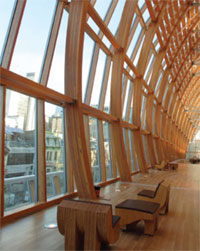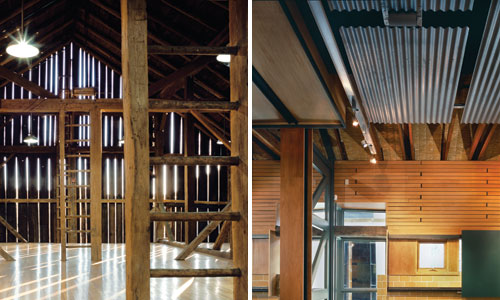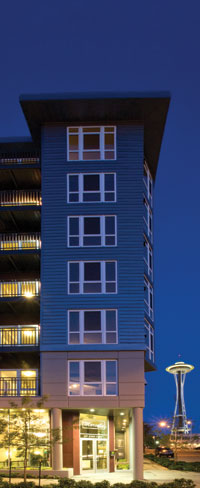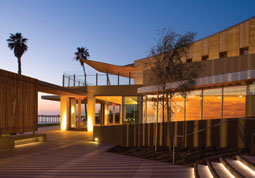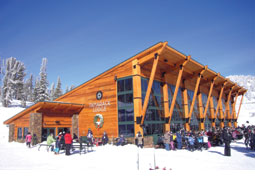Rethinking Wood as a Material of Choice
Conclusion
With growing pressure to reduce the carbon footprint of the built environment, building designers are increasingly being called upon to balance functionality and cost objectives with reduced environmental impact. Wood can typically help to achieve that balance.
Wood costs less—economically and environmentally—while delivering more in terms of its beauty, versatility and performance. It meets code requirements in a wide range of low- and mid-rise building types, and innovative new technologies continue to expand the possibilities for wood use in construction. Wood can also deliver a deep connection to nature that will only become more valuable in our built environment as humans continue to advance, and to stay the same.
Case Studies
| GALLERY RENOVATION Art Gallery of Ontario, Toronto, Ontario (Canada) Architect: Frank Gehry Completed: 2008 |
||
After the renovation of the existing gallery and addition of 92,000 square feet of new floor space, the Art Gallery of Ontario (AGO) has been called “the most complex wood structure in North America.” The Dundas Street facade includes 1,800 glulam members, each of which is unique, as are the 2,500 glulam connectors. The designers developed three-dimensional solid models and wireframe models for each glulam application, complete with calculated loads and member sizing. A wireframe of the models was sent to the subcontractor responsible for the connection engineering, detail drafting, manufacturing, delivery, and installation of the glulam. This information was used to develop a working solid model that included the glulam members, connections and hardware. The model was used to create shop drawings for approval and eventually for data input to the CNC equipment used to machine each glulam member to exacting tolerances and to shape the complex framing for each connector. In addition to the impressive structural applications, wood was used decoratively to provide visual highlights throughout the interior. |
| ADAPTIVE REUSE The Barn at Fallingwater, Mill Run, PA Architect: Bohlin Cywinski Jackson |
||
Adjacent to Frank Lloyd Wright’s Fallingwater, the Barn at Fallingwater is a renovated 19th century barn built into a hillside with a 1940s dairy barn addition. The 12,000-square-foot adaptive reuse project is the first phase of a conference complex for the Western Pennsylvania Conservancy. The Barn’s interior is rich with recycled and salvaged materials that celebrate the region’s agrarian heritage. A lattice screen was made of site-recycled tongue-and groove fir from an old ceiling. Contrasting the barn’s existing heavy-timber structure are new parallel strand lumber (PSL) members used as beams and columns in the lower barn. The existing heavy-timber structure of the bank barn was cleaned and left natural. A maple gym floor salvaged from a convent serves as the new thermal and moisture barrier between the two levels. Just over 81 percent of the construction debris was recycled. This project was completed by Bohlin Cywinski Jackson, a firm known for its innovative use of wood. It is featured in the U.S. Department of Energy’s High Performance Building Database. |
| CONDO EXPANSION Marselle Condominiums, Seattle, Washington Architect: PB Architects Completed: 2009 |
||
Wood-frame podium construction is nothing new, particularly for Seattle. But when developers built the Marselle Condominiums, they did something new by literally taking wood to the next level. By designing the 160,000-square-foot condo complex to meet Type III-A construction requirements, they were able to build five and one-half floors of wood over a two-story concrete podium deck. The combination of "five and one-half over two" made Marselle the tallest modern wood-frame structure in Seattle. The extra half-story mezzanine added about $250,000 to the construction cost of the building, but the architect and builder estimated that the added height and space increased the value of the complex by $1 million. From the outside, the Marselle looks like a typical 132-unit condominium structure. But on closer inspection, wood framing added value in a number of ways. Located just north of the city’s downtown core, not far from Seattle's famous Space Needle, Marselle was certified Built SmartSM by Seattle City Light and constructed to meet the Master Builders Association Built Green™ program in part by utilizing wood as an earth-friendly, energy-efficient building material. Construction began in August 2007 and was completed in April 2009. Joe Hanley, president of Norcon, NW, Inc., said the use of wood contributed substantially to the speed with which the building was constructed. "The concrete and steel hotel right behind Marselle had a similarly-sized footprint, but floor-by-floor, our framing went up much faster. They had a lot of on-site welding but by using wood, we were able to work through all types of weather." |
| THE ENVIRONMENT | |||||
There are many remarkable examples of wood buildings that have been designed to blend with their environment, and give occupants a deep connection to nature inside and out. Two shown here closely combine the traditional values of wood with new techniques for sustainable building. |
|||||
| Robert Paine Scripps Forum for Science,
Society
and the Environment La Jolla, California Architect: Safdie Rabines Architects San Diego, California
This LEED-certified 300-person flexible auditorium space includes four ocean-front meeting rooms, a graduate student lounge, and a catering kitchen and restaurant. Roof framing is comprised of exposed Douglas fir beams. Certified plantation teak was used to accentuate interior and exterior elements. The design objective was to create a state-of-the-art conference center that felt casual, warm and inviting. |
Tamarack Ski Lodge Heavenly Lake Tahoe Ski Resort South Lake Tahoe, California Architect: Collaborative Design Studio Reno, Nevada
The wood materials used in this 500-seat restaurant with bar area, restroom facilities and support spaces include Douglas fir exterior and interior wall studs, structural plywood roof sheathing, resawn Douglas fir glulam roof beams, and Douglas fir 3x wood structural members. The intent of the building aesthetics was to create an appealing structure that blended into the dominant beauty of the surrounding mountain environment. This was accomplished by keeping the building’s massing simple in nature, exposing the “naturally” compatible wood structure, utilizing cedar wood siding as an exterior skin and incorporating wood detailing throughout the interior of the facility. |
||||
| ENDNOTES | |
| 1 | woodworks.org/wp-content/uploads/Marselle.pdf |
| 2 | Source: Werner, F. and Richter, K. 2007. Wooden building products in comparative LCA: A literature review. International Journal of Life Cycle Assessment, 12(7): 470-479 |
| 3 | Calculated by Dovetail Partners Inc. based on data from Natural Resources Canada and the USDA Forest Service. |
| 4 | Deforestation in Canada - What are the Facts, Natural Resources Canada; State of the World's Forests, 2011, United Nations Food and Agriculture Organization |
| 5 | U.S. WoodWorks Carbon Calculator, www.woodworks.org |
| 6 | www.solutionsforwood.com/_docs/reports/Wood_Human_Health_final-single.pdf |
 |
The reThink Wood initiative is a coalition of interests representing North America’s wood products industry and related stakeholders. The coalition shares a passion for wood and the forests they come from. Innovative new technologies and building systems have enabled longer wood spans, taller walls and higher buildings, and continue to expand the possibilities for wood use in construction. www.rethinkwood.com |




